 |
AGGREGATE DEMAND IN THE OPEN ECONOMY (Continued…):Why income might not rise |
| << AGGREGATE DEMAND IN THE OPEN ECONOMY(Continued…):Fixed exchange rates |
| AGGREGATE SUPPLY:The sticky-price model >> |
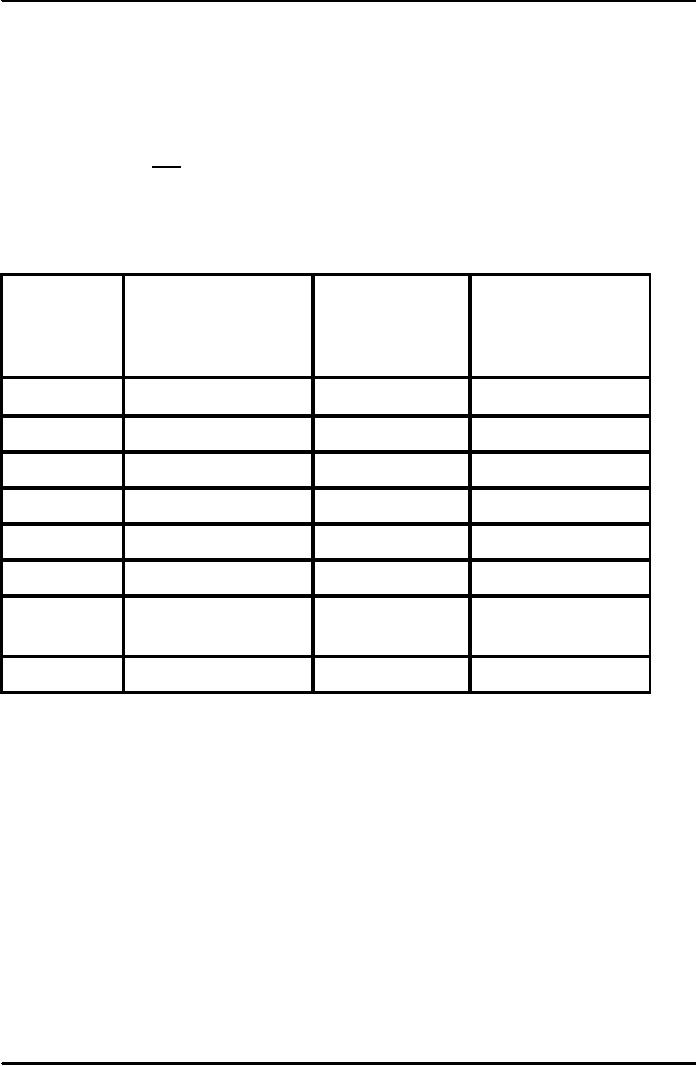
Macroeconomics
ECO 403
VU
LESSON
32
AGGREGATE
DEMAND IN THE OPEN ECONOMY
(Continued...)
Why income
might not rise
�
The
central bank may try to
prevent the depreciation by
reducing the money
supply
�
The
depreciation might boost the
price of imports enough to
increase the price level
(which
would
reduce the real money
supply)
�
Consumers
might respond to the
increased risk by holding
more money.
Each
of the above would shift LM*
leftward.
The
South East Asian
Crisis
stock
market %
nominal
GDP% change
exchange
rate% change
change
from 7/97 to
1997-98
from
7/97 to 1/98
1/98
Indonesia
-59.4%
-32.6%
-16.2%
Japan
-12.0%
-18.2%
-4.3%
Malaysia
-36.4%
-43.8%
-6.8%
Singapore
-15.6%
-36.0%
-0.1%
S.
Korea
-47.5%
-21.9%
-7.3%
Taiwan
-14.6%
-19.7%
n.a.
-1.2%
Thailand
-48.3%
-25.6%
(1996-97)
U.S.
n.a.
2.7%
2.3%
Floating
vs. Fixed Exchange
Rates
Argument
for floating rates:
�
Allows
monetary policy to be used to
pursue other goals (stable
growth, low
inflation)
Arguments
for fixed rates:
�
Avoids
uncertainty and volatility,
making international transactions
easier
�
Disciplines
monetary policy to prevent
excessive money growth &
hyperinflation
Mundell-Fleming
and the AD curve
�
Previously,
we examined the M-F model
with a fixed price level. To
derive the AD curve,
we
now
consider the impact of a
change in P in the M-F
model.
�
We
now write the M-F equations
as:
(IS* )
Y
= C
(Y
- T
) +
I (r
*) +
G + NX
(ε
)
151
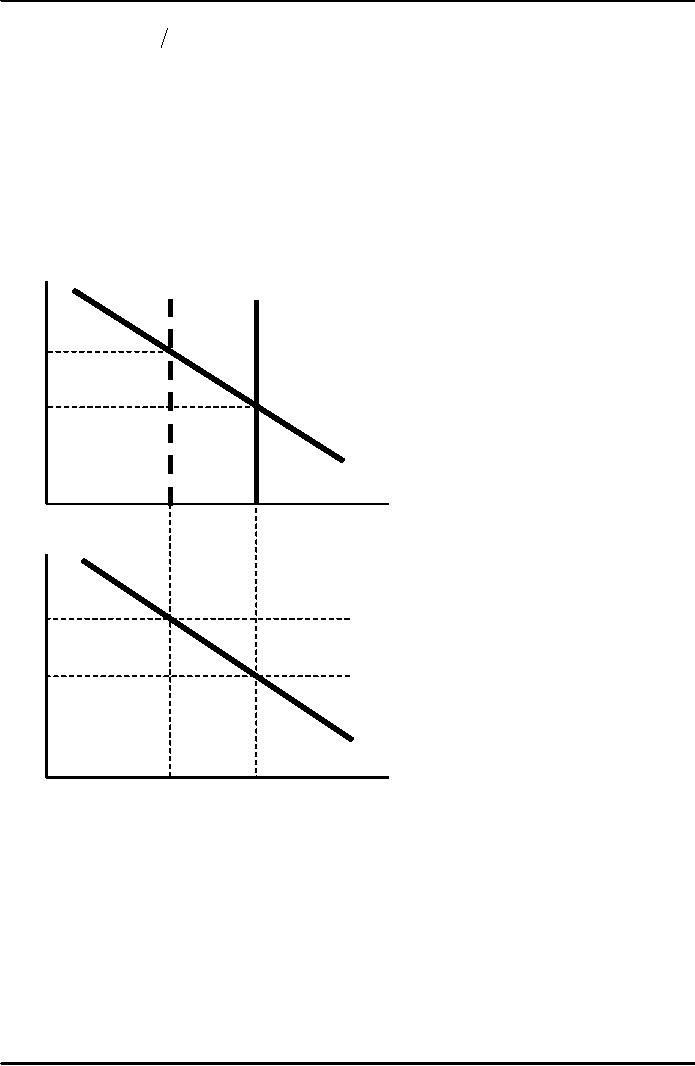
Macroeconomics
ECO 403
VU
(LM* )
M
P = L
(r
*,Y
)
(Earlier,
we could write NX as a function of e
because e and ε
move in
the same direction
when
P is fixed.)
Deriving
the AD
curve
Why
AD curve has negative
slope:
↑P
⇒
↓(M/P)
⇒
LM shifts
left
⇒
↑ε
⇒
↓NX
⇒
↓Y
LM*(P2)
ε
LM*(P1)
ε2
ε1
IS*
Y1
Y
Y2
P
P2
P1
AD
Y
Y2
Y1
From
short run to the long
run
If
Y1 < Y then there is downward
pressure on prices. Over
time, P will move down,
causing
(M/P)↑
ε↓
NX
↑
Y↑
152
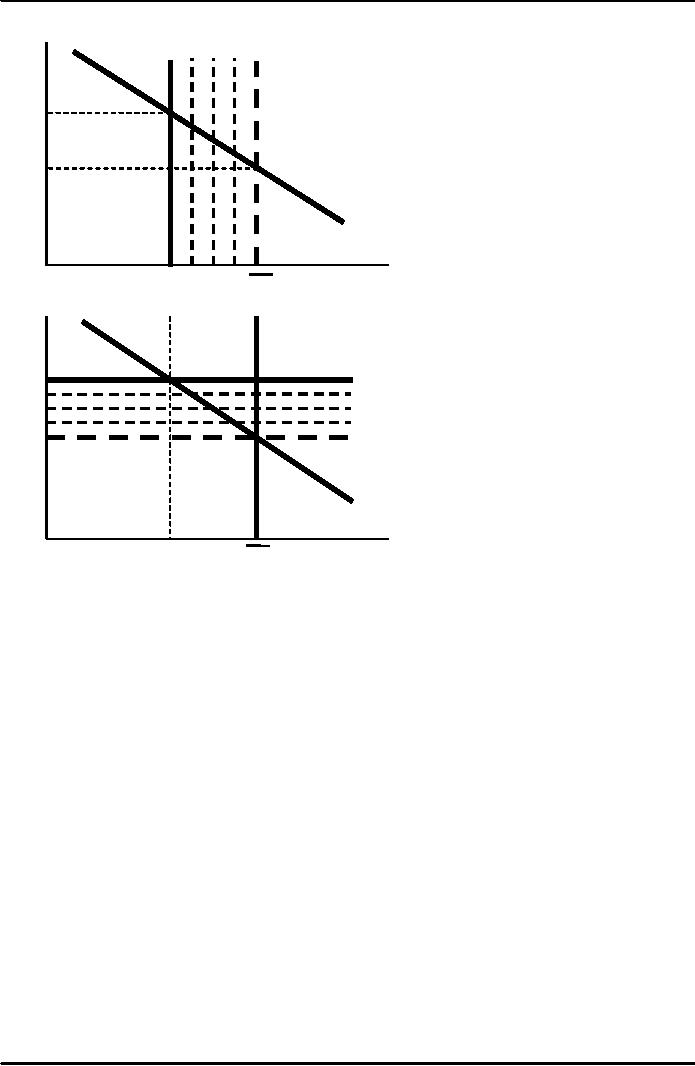
Macroeconomics
ECO 403
VU
LM*(P1)
ε
LM*(P2)
ε1
ε2
IS*
Y
Y1
Y
P
LRAS
P1
SRAS1
SRAS2
P2
AD
Y
Y1
Y
Large:
between small and
closed
�
Many
countries - including the
U.S. - are neither closed
nor small open
economies.
�
A
large open economy is in
between the polar cases of
closed & small
open.
�
Consider
a monetary expansion:
�
Like
in a closed economy,
ΔM > 0 ⇒
↓r ⇒ ↑I (though
not as much)
�
Like
in a small open
economy,
ΔM > 0 ⇒
↓ε ⇒ ↑NX
(though not as much)
153
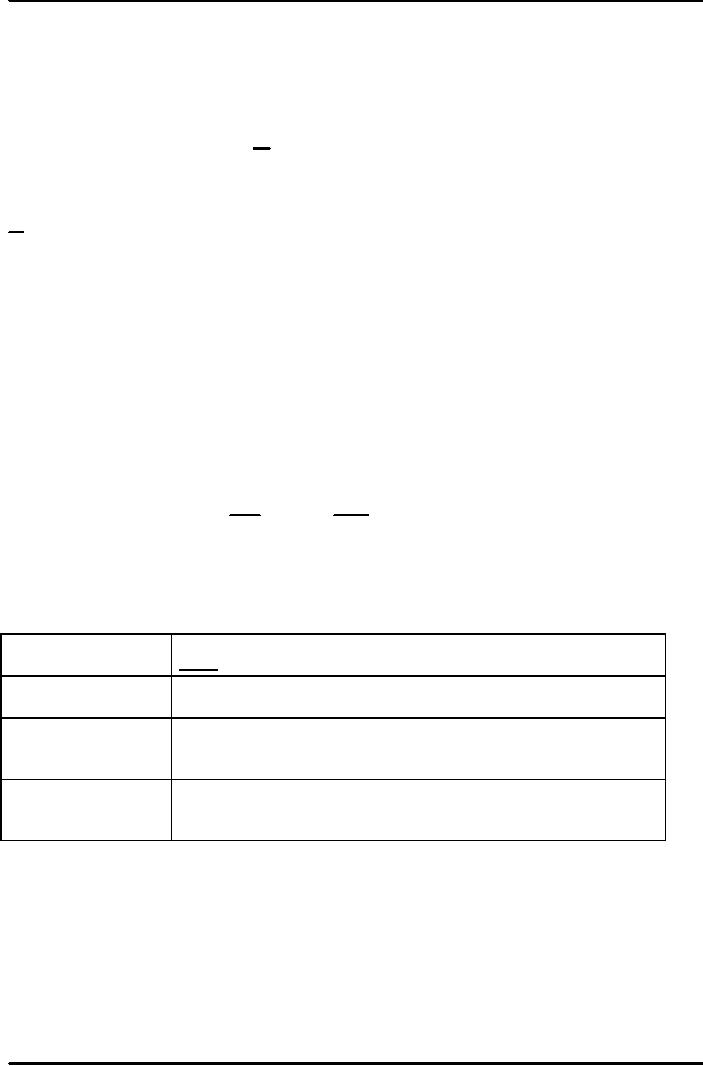
Macroeconomics
ECO 403
VU
THREE
MODELS OF AGGREGATE
SUPPLY
�
The
sticky-wage model
�
The
imperfect-information model
�
The
sticky-price model
All
three models imply:
Y
= Y
+ α (P
- P
e )
Where:
Y
Aggregate
output
Y
Natural
rate of output
α
a
positive parameter
P
the
actual price level
e
P
the
expected price level
The
sticky-wage model
�
Assumes
that firms and workers
negotiate contracts and fix
the nominal wage before
they
know
what the price level
will turn out to
be.
�
The
nominal wage, W, they set is
the product of a target real
wage, ω, and
the expected
price
level:
W
= ω
�Pe
Pe
W
=ω�
⇒
P
P
If
Then
P
= Pe
Unemployment
and output are at their
natural rates
P
> Pe
Real
wage is less than its
target, so firms hire more
workers and
output
rises above its natural
rate
P
< Pe
Real
wage exceeds its target, so
firms hire fewer workers
and
output
falls below its natural
rate
154
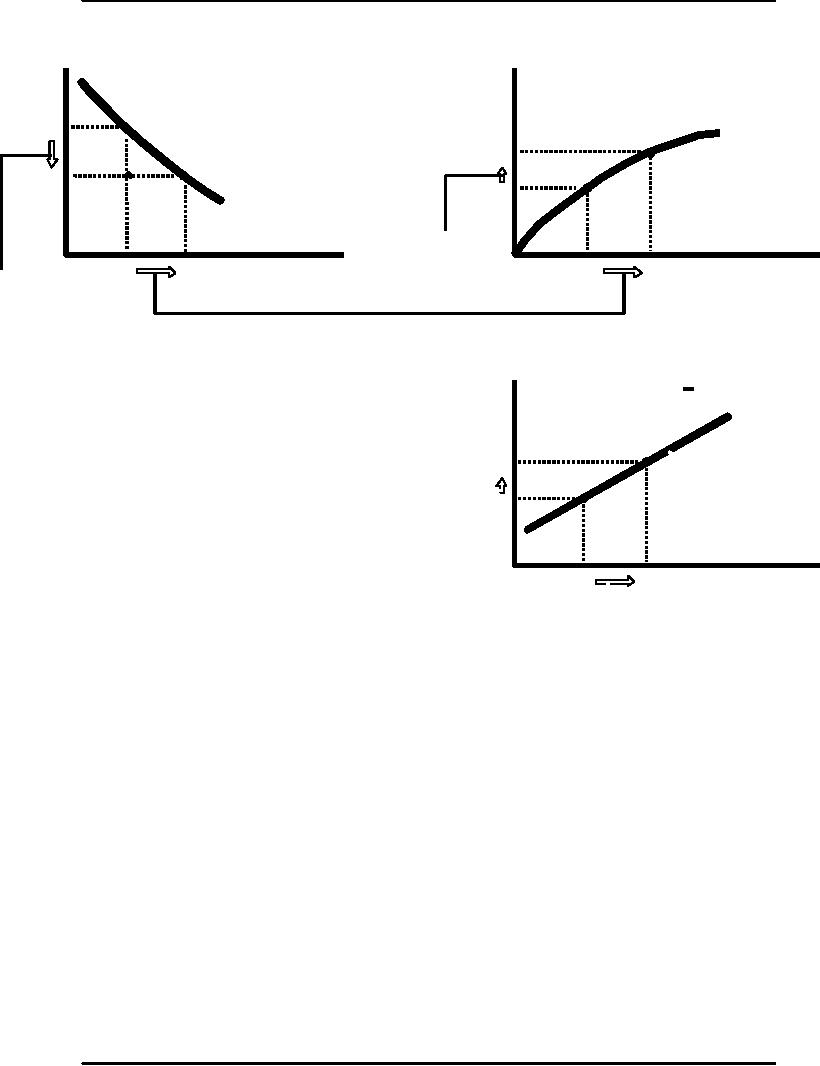
Macroeconomics
ECO 403
VU
(a)
Labor Demand
(b)
Production Function
Real
wage,
Income,
Y
output,
W/P
W/P1
Y
= F (L )
Y
2
W/P2
Y
L
= Ld
(W/P
)
1
... output,.
.
4.
Labor,
Labor,
L
L
L
L
L
L
2.
. . . Reduces
1
2
1
2
the
real
wage
3....hich
raises
w
for
a given
employment. .
,
nominal
wage,.
.
(c)
Aggregate Supply
Price
level,
P
Y
= Y + α
(P
-P
e)
P
2
6.
The aggregate
supply
curve
P
1
summarizes
these
changes.
1.
An increase
in
the price
Income,
output,
Y
Y
Y
2
1
level.
.
...
and
income.
5.
The
sticky-wage model
�
Implies
that the real wage
should be counter-cyclical, it should
move in the opposite
direction
as output over the course of
business cycles:
In booms,
when P typically rises, the
real wage should
fall.
In recessions,
when P typically falls, the
real wage should
rise.
�
This
prediction does not come
true in the real
world:
155
Table of Contents:
- INTRODUCTION:COURSE DESCRIPTION, TEN PRINCIPLES OF ECONOMICS
- PRINCIPLE OF MACROECONOMICS:People Face Tradeoffs
- IMPORTANCE OF MACROECONOMICS:Interest rates and rental payments
- THE DATA OF MACROECONOMICS:Rules for computing GDP
- THE DATA OF MACROECONOMICS (Continued…):Components of Expenditures
- THE DATA OF MACROECONOMICS (Continued…):How to construct the CPI
- NATIONAL INCOME: WHERE IT COMES FROM AND WHERE IT GOES
- NATIONAL INCOME: WHERE IT COMES FROM AND WHERE IT GOES (Continued…)
- NATIONAL INCOME: WHERE IT COMES FROM AND WHERE IT GOES (Continued…)
- NATIONAL INCOME: WHERE IT COMES FROM AND WHERE IT GOES (Continued…)
- MONEY AND INFLATION:The Quantity Equation, Inflation and interest rates
- MONEY AND INFLATION (Continued…):Money demand and the nominal interest rate
- MONEY AND INFLATION (Continued…):Costs of expected inflation:
- MONEY AND INFLATION (Continued…):The Classical Dichotomy
- OPEN ECONOMY:Three experiments, The nominal exchange rate
- OPEN ECONOMY (Continued…):The Determinants of the Nominal Exchange Rate
- OPEN ECONOMY (Continued…):A first model of the natural rate
- ISSUES IN UNEMPLOYMENT:Public Policy and Job Search
- ECONOMIC GROWTH:THE SOLOW MODEL, Saving and investment
- ECONOMIC GROWTH (Continued…):The Steady State
- ECONOMIC GROWTH (Continued…):The Golden Rule Capital Stock
- ECONOMIC GROWTH (Continued…):The Golden Rule, Policies to promote growth
- ECONOMIC GROWTH (Continued…):Possible problems with industrial policy
- AGGREGATE DEMAND AND AGGREGATE SUPPLY:When prices are sticky
- AGGREGATE DEMAND AND AGGREGATE SUPPLY (Continued…):
- AGGREGATE DEMAND AND AGGREGATE SUPPLY (Continued…):
- AGGREGATE DEMAND AND AGGREGATE SUPPLY (Continued…)
- AGGREGATE DEMAND AND AGGREGATE SUPPLY (Continued…)
- AGGREGATE DEMAND AND AGGREGATE SUPPLY (Continued…)
- AGGREGATE DEMAND IN THE OPEN ECONOMY:Lessons about fiscal policy
- AGGREGATE DEMAND IN THE OPEN ECONOMY(Continued…):Fixed exchange rates
- AGGREGATE DEMAND IN THE OPEN ECONOMY (Continued…):Why income might not rise
- AGGREGATE SUPPLY:The sticky-price model
- AGGREGATE SUPPLY (Continued…):Deriving the Phillips Curve from SRAS
- GOVERNMENT DEBT:Permanent Debt, Floating Debt, Unfunded Debts
- GOVERNMENT DEBT (Continued…):Starting with too little capital,
- CONSUMPTION:Secular Stagnation and Simon Kuznets
- CONSUMPTION (Continued…):Consumer Preferences, Constraints on Borrowings
- CONSUMPTION (Continued…):The Life-cycle Consumption Function
- INVESTMENT:The Rental Price of Capital, The Cost of Capital
- INVESTMENT (Continued…):The Determinants of Investment
- INVESTMENT (Continued…):Financing Constraints, Residential Investment
- INVESTMENT (Continued…):Inventories and the Real Interest Rate
- MONEY:Money Supply, Fractional Reserve Banking,
- MONEY (Continued…):Three Instruments of Money Supply, Money Demand